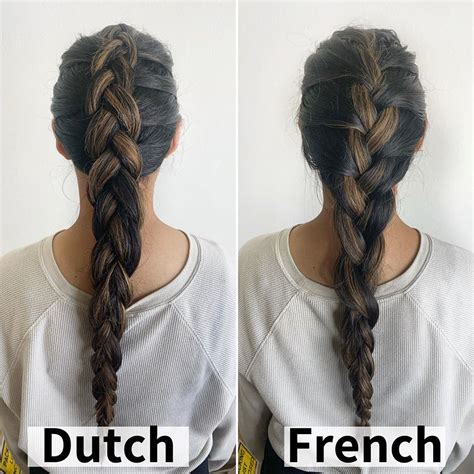Comparing Techniques, Difficulty, Pain, and Styling Options

Dutch Braids
What are Dutch Braids?
Dutch braids (also known as “inside-out” braids) are a type of three-strand braid where the hair strands are crossed under rather than over, creating a raised effect that adds volume and texture to the hair.
Technique
To create a Dutch braid:
- Divide the hair into three equal sections.
- Cross the rightmost strand under the middle strand.
- Cross the leftmost strand under the new middle strand.
- Continue alternating, crossing the outer strands under the middle strand.
- Secure the end of the braid with a hair tie.
French Braids
What are French Braids?
French braids (also known as “outside-in” braids) are a classic three-strand braid where the hair strands are crossed over rather than under, creating a smooth, flat appearance.
Technique
To create a French braid:
- Divide the hair into three equal sections.
- Cross the rightmost strand over the middle strand.
- Cross the leftmost strand over the new middle strand.
- Add a small section of hair from the side into the rightmost strand before crossing it over.
- Add a small section of hair from the side into the leftmost strand before crossing it over.
- Continue alternating, crossing the outer strands over the middle strand and adding sections of hair from the sides.
- Secure the end of the braid with a hair tie.
Dutch Braids vs French Braids: Key Differences
| Feature | Dutch Braids | French Braids |
|---|---|---|
| Appearance | Raised, voluminous | Flat, smooth |
| Crossing Direction | Strands crossed under | Strands crossed over |
| Difficulty | Moderate | Easy |
| Pain | May cause slight discomfort in the beginning | Less painful |
| Versatility | Can be styled in various ways | More limited styling options |
Pain Comparison
Dutch Braids:
- Can cause slight discomfort in the beginning as the hair is pulled tightly under the strands.
- Pain tends to subside as the braid loosens and the hair adjusts.
French Braids:
- Generally less painful than Dutch braids due to the strands being crossed over rather than under.
- May cause mild pain if the braid is pulled too tightly or if the hair is coarse or thick.
Styling Options
Dutch Braids:
- Crown Braid: A braid that wraps around the head like a crown, adding height and volume.
- Half-Up Dutch Braid: A braid that starts at the crown and ends at the nape of the neck.
- Fishtail Dutch Braid: A Dutch braid where the strands are divided into two thinner sections and crossed over in a fishtail pattern.
French Braids:
- Single French Braid: A classic braid that hangs down the back.
- Double French Braids: Two French braids that start at the top of the head and end at the nape of the neck.
- Braided Bun: A French braid that is wrapped into a bun.
Which Braid is Right for You?
The choice between a Dutch braid and a French braid depends on your individual preferences and hair type:
- Voluminous Hair: Dutch braids are ideal for adding volume and texture to thin or flat hair.
- Smooth Hair: French braids are best suited for smooth, sleek hair that won’t frizzy or tangle.
- Beginners: French braids are easier to learn than Dutch braids, making them a good choice for beginners.
- Pain Tolerance: French braids are typically less painful than Dutch braids.
Common Motivations for Braiding Hair
- Style and Aesthetics: Braids can enhance the appearance of hair, making it look more polished, elegant, or edgy.
- Convenience: Braids can keep hair out of the face and prevent tangles, especially during activities like sports or sleep.
- Hair Care: Braiding can protect hair from damage caused by heat styling or environmental factors.
- Tradition and Culture: Braids have historical and cultural significance in many societies around the world.
Effective Strategies for Painless Braiding
- Use a detangling spray to reduce knots and make the hair easier to braid.
- Start with slightly damp hair, as dry hair tends to be more brittle and prone to breakage.
- Braid gently, avoiding pulling the hair too tightly.
- Take breaks if you experience any pain or discomfort.
- Use hair clips to hold the hair in place while you braid.
- Massage the scalp gently after braiding to promote circulation.
Benefits of Braiding Hair
- Reduced Hair Breakage: Braiding can protect the hair from mechanical damage caused by brushing, styling, or friction.
- Moisture Retention: By keeping the hair strands tightly intertwined, braiding helps to lock in moisture and prevent dryness.
- Enhanced Scalp Health: Massaging the scalp while braiding can stimulate blood flow and promote hair growth.
- Versatile Styling: Braids can be styled in endless ways to suit different occasions and hair types.
- Improved Hair Quality: Over time, regular braiding can strengthen the hair and improve its overall health.
Creative New Word: “Braidology”
Braidology is a term coined to describe the art and science of braiding hair. It encompasses the techniques, styles, and benefits associated with braiding. Braidology can be further explored to develop innovative braiding techniques and applications.
Conclusion
Dutch braids and French braids are both versatile and stylish hair braiding techniques that offer different advantages. By understanding their key differences and benefits, you can choose the braid that best suits your hair type, style, and preferences. Whether you’re a beginner looking to master the basics or an experienced braider seeking new inspiration, the world of braidology awaits your exploration.
